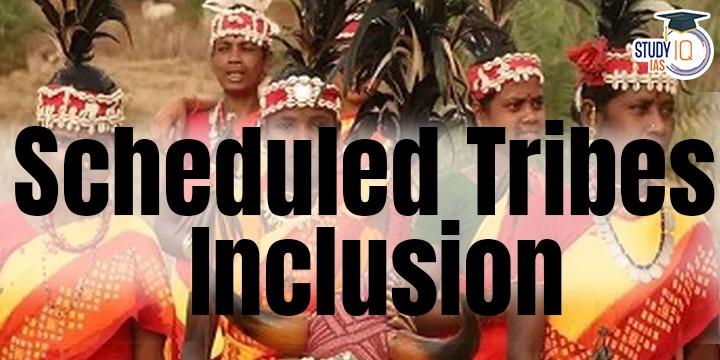Table of Contents
Scheduled Tribes Inclusion
- The Cabinet in its latest decision granted the status of Scheduled Tribes to the Hattee community of Himachal Pradesh’s Sirmaur district.
- The Cabinet approved the inclusion of ‘Gonds’ along with its five sub-castes in the Bhadohi district of Uttar Pradesh in the Scheduled Tribes list of Uttar Pradesh.
- The inclusion of ‘Narikoravan along with the Kurivikkaran’ community in respect to the State of Tamil Nadu was also approved by the Cabinet through the introduction of a Bill in Parliament to amend the Constitution Order,1950.
- The inclusion of the ‘Betta-Kuruba’ community in respect to the State of Karnataka was also approved by the Cabinet.
- Chhattisgarh’s 12 caste communities were included in the Scheduled Tribes.

Read about: Scheme of Development of Particularly Vulnerable Tribal Groups
Scheduled Tribes in India
- According to the Scheduled Tribes in India as revealed in Census 2011, there are said to be 705 ethnic groups listed as Scheduled Tribes under Article 342.
- Over 10 crore Indians are notified as STs, of which 1.04 crore live in urban areas.
- The Scheduled Tribes constitute 8.6% of the population and 11.3% of the rural population.
- The UTs of Chandigarh, Delhi, and Puducherry, as well as the States of Haryana and Punjab, have not designated any community as a Scheduled Tribe.
- Following the division of the Ministry of Social Justice and Empowerment, the Government of India established the Ministry of Tribal Affairs.
List of Scheduled Tribes in India
- According to Article 342, some tribal communities, sections of tribes, or groupings within tribes are considered Scheduled Tribes with reference to that State or UT.
- These listings are only applicable inside the boundaries of that State or UT.
- An area that has been designated as a Scheduled Tribe in one State need not also be so in another.
- A community may be added to the Scheduled Tribe list at any time.

Tribe’s Inclusion on the Scheduled Tribe List
- Criteria of Inclusion: Ethnological traits, traditional characteristics, distinctive culture, geographical isolation and backwardness.
- At State/UT Level: Process begins at the level of a State or Union Territory, with the concerned government or administration seeking the addition or exclusion of a particular community from the SC or ST list.
- At Union Level: Proposal to include or remove any community from the Scheduled List is sent to the Union Ministry of Tribal Affairs from the concerned State government
- Ministry of Tribal Affairs, through its own deliberations, examines the proposal, and sends it to the Registrar General of India (RGI), which is sent to the National Commission for Scheduled Castes or National Commission for Scheduled Tribes.
- After inter-ministerial deliberations, proposal is introduced in the Cabinet for final approval.
- At President Office: The final decision rests with the President’s office issuing a notification specifying the changes under powers vested in it from Articles 341 and 342.
- The inclusion or exclusion come into effect only after the President assents to a Bill that amends the Constitution (Scheduled Castes) Order, 1950 and the Constitution (Scheduled Tribes) Order, 1950, as is appropriate, after it is passed by both the Lok Sabha and Rajya Sabha.
Supreme Court Judgement on Scheduled Tribes Inclusion
- The Supreme Court in march 2022, wants to fix fool–proof parameters to determine if a person belongs to a Scheduled Tribe and is entitled to the benefits due to the community.
- However, judiciary is no longer sure about an “affinity test” used to sift through anthropological and ethnological traits to link a person to a tribe.
- There is the likelihood that contact with other cultures, migration and modernisation would have erased the traditional characteristics of a tribe.
- Thereafter, Supreme Court’s decided to refer the question to a larger Bench
























 WhatsApp
WhatsApp